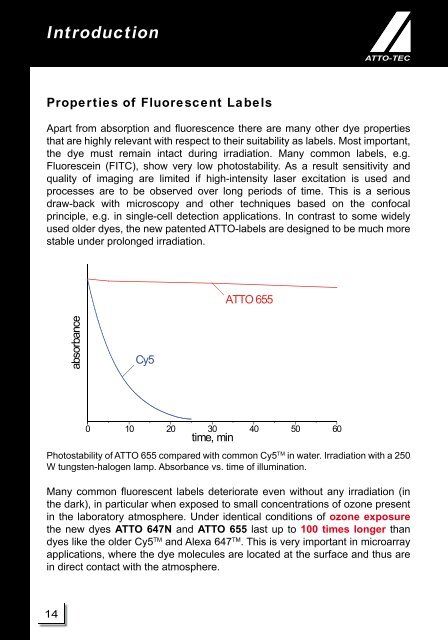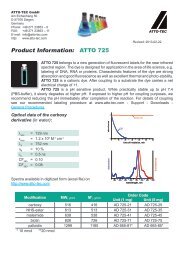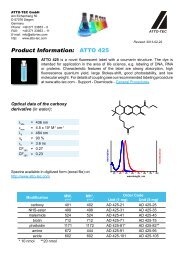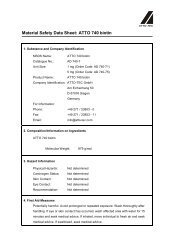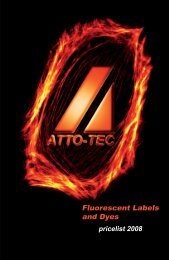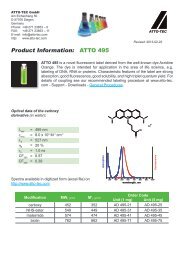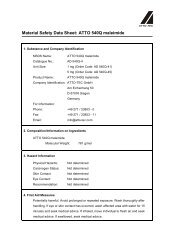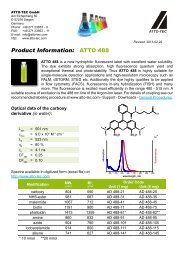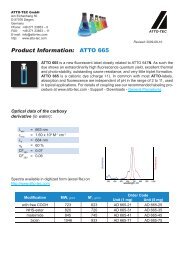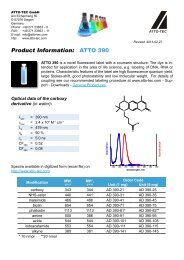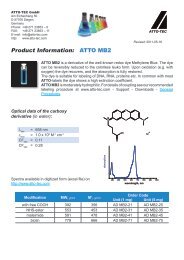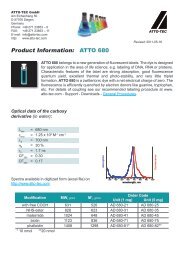Fluorescent Labels and Dyes - ATTO-TEC GmbH
Fluorescent Labels and Dyes - ATTO-TEC GmbH
Fluorescent Labels and Dyes - ATTO-TEC GmbH
Create successful ePaper yourself
Turn your PDF publications into a flip-book with our unique Google optimized e-Paper software.
Introduction<br />
Properties of <strong>Fluorescent</strong> <strong>Labels</strong><br />
Apart from absorption <strong>and</strong> fl uorescence there are many other dye properties<br />
that are highly relevant with respect to their suitability as labels. Most important,<br />
the dye must remain intact during irradiation. Many common labels, e.g.<br />
Fluorescein (FITC), show very low photostability. As a result sensitivity <strong>and</strong><br />
quality of imaging are limited if high-intensity laser excitation is used <strong>and</strong><br />
processes are to be observed over long periods of time. This is a serious<br />
draw-back with microscopy <strong>and</strong> other techniques based on the confocal<br />
principle, e.g. in single-cell detection applications. In contrast to some widely<br />
used older dyes, the new patented <strong>ATTO</strong>-labels are designed to be much more<br />
stable under prolonged irradiation.<br />
absorbance<br />
Cy5<br />
<strong>ATTO</strong> 655<br />
0 10 20 30 40 50 60<br />
time, min<br />
Photostability of <strong>ATTO</strong> 655 compared with common Cy5 TM in water. Irradiation with a 250<br />
W tungsten-halogen lamp. Absorbance vs. time of illumination.<br />
Many common fl uorescent labels deteriorate even without any irradiation (in<br />
the dark), in particular when exposed to small concentrations of ozone present<br />
in the laboratory atmosphere. Under identical conditions of ozone exposure<br />
the new dyes <strong>ATTO</strong> 647N <strong>and</strong> <strong>ATTO</strong> 655 last up to 100 times longer than<br />
dyes like the older Cy5 TM <strong>and</strong> Alexa 647 TM . This is very important in microarray<br />
applications, where the dye molecules are located at the surface <strong>and</strong> thus are<br />
in direct contact with the atmosphere.<br />
Introduction<br />
Besides reduced background, an advantage of excitation in the red spectral<br />
region is that rugged diode lasers can be used in place of gas lasers. Diode<br />
lasers are generally less expensive <strong>and</strong> more energy-effi cient. Furthermore<br />
a variety of sensitive detectors is now available for the visible-near-IR region.<br />
Excitation in the red spectral region is also advantageous when working with<br />
live cells, because damage is reduced.<br />
The fl uorescence effi ciency of dyes is highest in the blue <strong>and</strong> green region of the<br />
spectrum. Here the quantum yield reaches in some cases almost the theoretical<br />
limit of 100 %. Towards longer wavelengths the effi ciency drops drastically, in<br />
particular so in aqueous solution. However, <strong>ATTO</strong>-<strong>TEC</strong> has been able to develop<br />
labels that show high quantum yield even around 650 nm: The new <strong>ATTO</strong> 647N<br />
fl uoresces in aqueous solution twice as strong as the old Cy5 TM .<br />
600 700 800<br />
wavelength, nm<br />
14 15<br />
fluorescence intensity<br />
<strong>ATTO</strong> 647N, 66 %<br />
Cy5, 32 %<br />
Fluorescence quantum yield of <strong>ATTO</strong> 647N compared with common Cy5 TM in<br />
water. Solutions of equal absorbance excited at 647 nm. Fluorescence intensity vs.<br />
wavelength.


